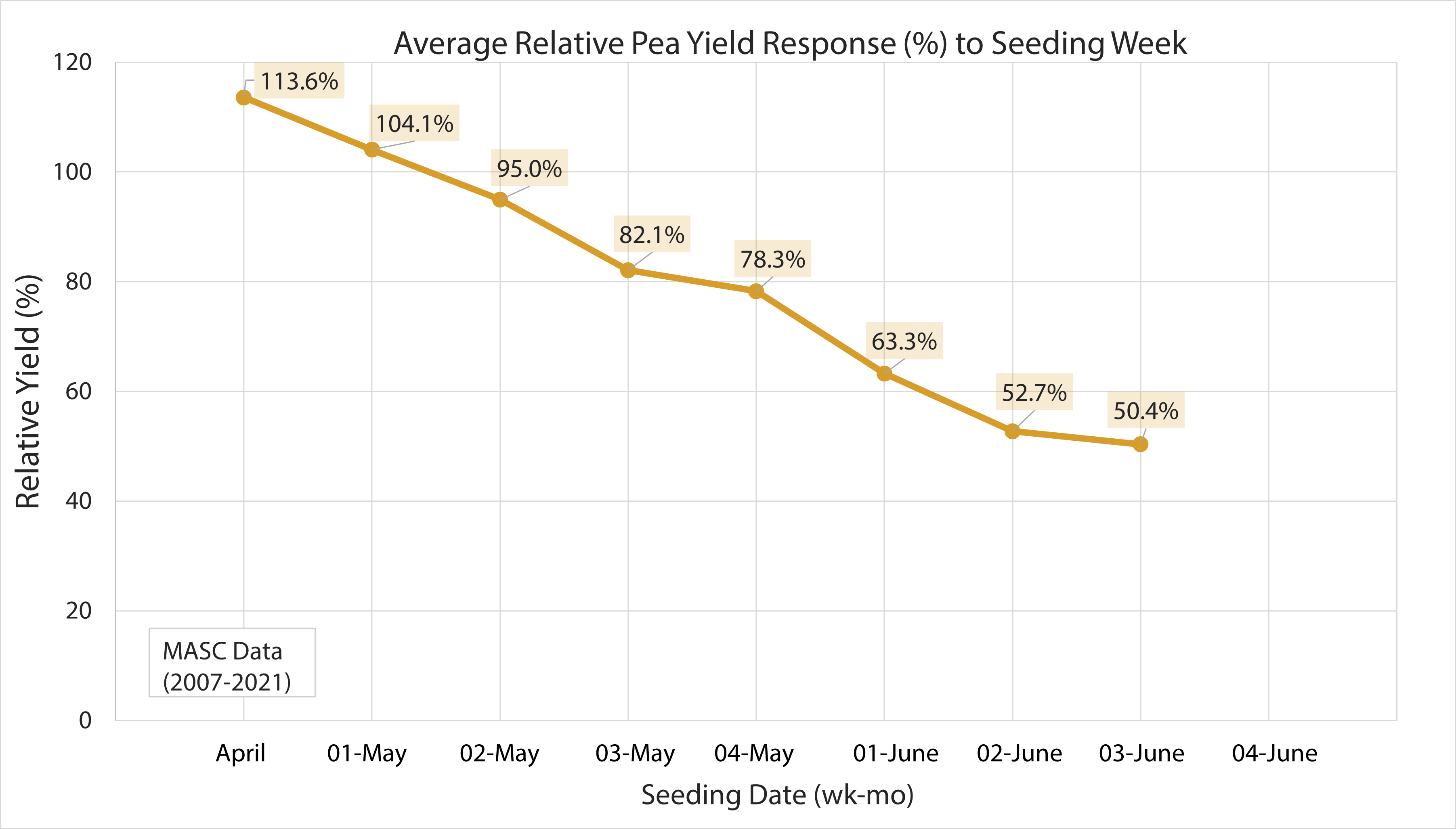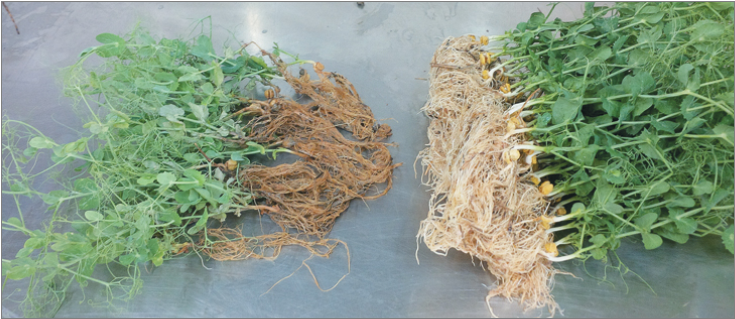Seeding Date
Seed peas as early as possible from late April to early May for maximum yield potential. Peas are more tolerant to spring frost than other crops because pea cotyledons remain underground. If frost injury occurs, new shoots will emerge from axillary buds that are protected under the soil surface. Early planting also means peas flower and pod earlier in the summer, avoiding heat blasting of flower buds and peak pea aphid populations.

Soil Temperature
Unlike soybeans, peas are very tolerant to cool soil temperatures. Cooler soil caused by surface residue in no-till systems will not be detrimental, but the mulch may trap excess moisture. The minimum soil temperatures for germination to occur in peas is 4°C.
Preceding Crop
Peas are commonly grown following wheat, cereals or canola. According to MASC data (2011-2020), relative yield response of peas is greatest following red spring wheat, canola or soybeans.

Target Plant Stand and Seeding Rate
Target 80-90 live plants/m2 (320,000-360,000 plants/ac, 7-8 plants/ft2). Adjust the seeding rate (lbs/ac) to account for expected seedling survival and seed weight, which varies considerably among market class, variety and seed lot. Typical seedling survival for peas is 85%. Thousand seed weight typically ranges from 125-300 grams. Use high quality, crack-free seed if possible and handle seed gently to prevent damage.
Conduct a soak test to assess seed damage:
Place 200 seeds in water and calculate the percentage of seeds that swell. Seeds that lose their seed coat will not produce a viable plant.
Seeding Depth
Seed peas at 1.5-2 inches deep, ensuring they are planted into moisture.
Weed Control
Early season weed control is important for preventing yield loss, as peas are poor competitors against weeds. Pre-emergent herbicides can offer control of Group 2-resistant broadleaf weeds, which have limited in-crop control options. Pea yield can be reduced by up to 25% if weed control is delayed until four weeks after emergence.2
Inoculant
Inoculate peas with Rhizobium leguminosarum bacteria, even on fields with a history of peas. This will help facilitate root nodule development and nitrogen fixation. Consider double inoculating fields with no history of peas or using a granular inoculant when seeding conditions are unfavourable (e.g., drought, excess moisture, acidic soil).
Seed Treatment
Fungicide seed treatment will protect peas against infection of Aphanomyces euteiches, Fusarium oxysporum and F. avenaceum for up to three weeks after planting. Seed treatment is recommended for peas planted in short rotations or when soil conditions are cool, wet or compacted. A minimum of 4 years between pea crops is recommended to minimize yield-limiting disease. Fields diagnosed with Aphanomyces should be cropped to peas only once every 7-8 years to reduce inoculum levels in soil and avoid yield loss from this disease.

Presence or absence of Aphanomyces can be confirmed by sending soil or plant tissue samples to 20/20 Seed Labs. Research on Aphanomyces is ongoing at Agriculture and Agri-Food Canada – Lethbridge, led by Dr. Syama Chatterton. This research is focused on identifying the distribution of Aphanomyces across western Canada, DNA detection in soils, threshold inoculum levels, changes in inoculum over time and management options such as crop rotation and seed treatments.
Rolling
Land rolling can greatly improve harvestability and reduce earth tag on seed, even on soil without stones. Rolling can be done immediately after seeding or post-emergence up to the 5th node stage. If rolling post-emergence, roll during the warmest part of the day. Avoid rolling as the crop is just emerging or if the crop is stressed from herbicide or frost.
References:
1 MASC. Relative stubble yield response (2011-2020).
2 Harker, K.N., R.E. Blackshaw and G.W. Clayton. 2001. Timing weed removal in field pea (Pisum sativum). Weed Tech. 15:277-283.
